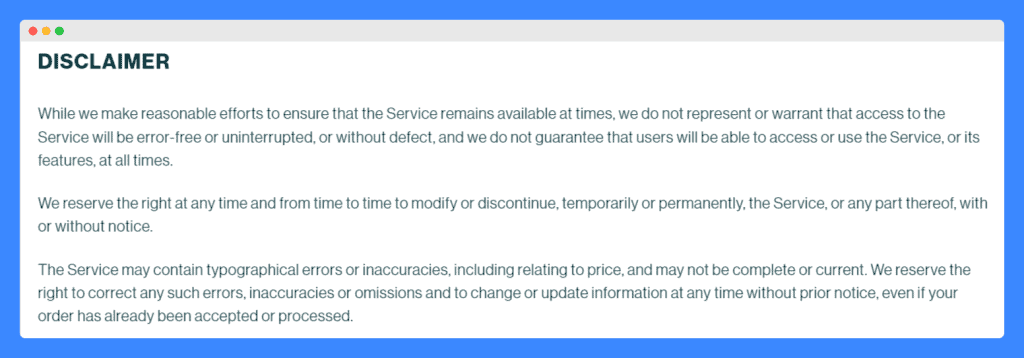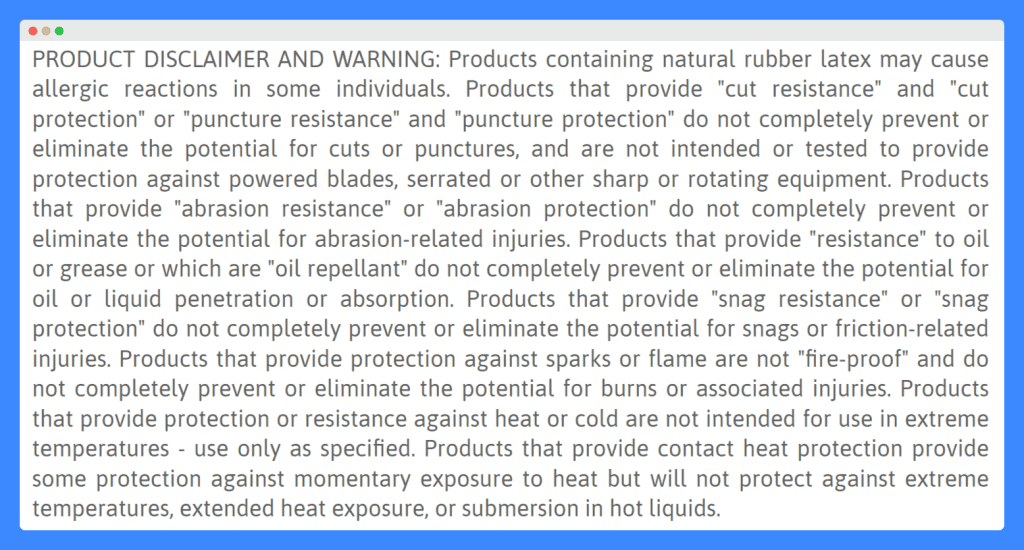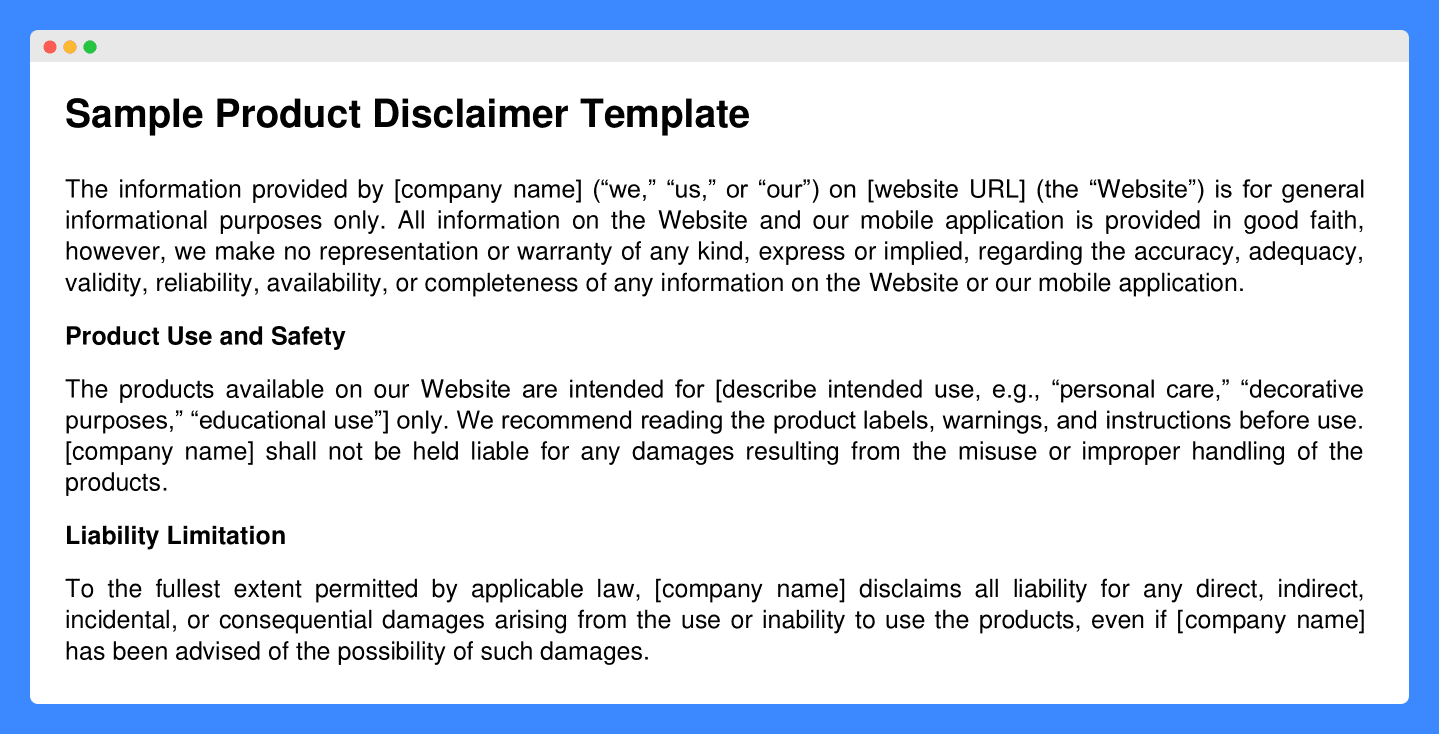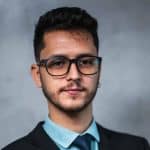Opening your online store can feel like launching into uncharted waters — exciting, yet filled with unknowns. One way to help navigate these waters is to understand what is a product disclaimer.
A product disclaimer is a written statement designed to limit your liability in case of any mishaps involving your products. It informs your customers about the limitations of your product, which in turn sets clear expectations and protects your business legally.
To help ensure your product disclaimer saves you headaches down the line, we’ll talk about its different types, why you need one, and the key components every online business owner should include in it.
- Use clear, visible product disclaimers to reduce liability and inform customers of limitations. Make sure they’re legally enforceable and in line with consumer protection laws.
- Regularly review and update your disclaimers annually or when product features, business practices, or regulations change to maintain accuracy and legal compliance.
- Ensure customers read disclaimers by making them visible during checkout and requiring acknowledgment, such as a checkbox, before completing their purchase.
Table of Contents
PRO TIP: Take the hassle of writing your own disclaimer away with our disclaimer generator trusted by over 200,000 businesses. It’ll save you hours of work and possible costly legal mistakes.
Types of Product Disclaimers
Product disclaimers come in various types, each designed to address specific aspects of a product or service and manage the expectations of consumers.
Here’s a breakdown of the different types of product disclaimers commonly used by online businesses:
As Is or No Warranty Product Disclaimer
This type of product warranty disclaimer clearly states that the product is sold “as is” and the seller disclaims all warranties, express or implied.
It indicates that the product comes without a warranty of any kind. In turn, this signals to buyers that they are assuming all risks associated with the product’s condition upon purchase.
PRO TIP: An “as is” or no warranty disclaimer is ideal for stores selling used goods or digital products, where it’s impractical to guarantee flawless condition or compatibility.
Limited Warranty Product Disclaimer
This type of disclaimer lets customers know exactly what aspects of the product are covered by warranties and the specific conditions under which they can claim these warranties. It also clearly defines the scope and duration of any warranties provided.
No Guarantee Product Disclaimer
This disclaimer would clearly articulate that the business makes no guarantees about the outcomes of using a product.
This is especially useful for products where results may vary based on user implementation or external factors, like health and fitness programs.
Exclusive Obligation Product Disclaimer
These disclaimers usually state that the products have been designed for specific uses only. Moreover, they often mention that any additional responsibilities not explicitly mentioned are not assumed by the seller.
Limitation of Liability Product Disclaimer
This type of product disclaimer states that the seller makes no representations or warranties beyond those explicitly outlined. It limits the business’s liability for any additional claims related to the product’s performance or quality.
Why Do You Need a Product Disclaimer for Your Website?
You need a product disclaimer for your website because it clarifies the extent of your responsibilities as a seller. It also helps ensure customers understand the limitations and risks associated with your product.
In other words, you need a product disclaimer:
- To Limit Legal Liability: You use a disclaimer to protect your business from any legal liability whatsoever arising from the use or misuse of your products. This is essential to prevent costly lawsuits and claims.
- To Clarify Product Use and Suitability: Disclaimers provide specific information on the suitability and proper use of a product, helping to manage customer expectations and prevent misunderstandings.
- To Disclaim Warranties: You can use a disclaimer to state that your business cannot be held liable for any defect or lack of performance. It can include statements rejecting warranties of merchantability and fitness for a particular purpose.
- To Protect Against Claims for Damages: By stating that your company is not responsible for incidental damages or consequential damages, you limit exposure to claims for unforeseen expenses that might arise from product use.
- To Comply with U.S. Regulations: In the U.S., certain types of product disclaimers are legally required in various industries to ensure consumers are fully informed about what they are purchasing.
For instance, under the Food, Drug, and Cosmetic Act (FDCA), products like supplements and cosmetics must clearly state that the FDA has not evaluated their claims.
Moreover, these products must include disclaimers if they claim to diagnose, treat, cure, or prevent any disease, ensuring consumers understand these are not medically endorsed products.
Product disclaimers work to safeguard your business while providing essential information to your customers. They are a vital part of a business’ risk management strategy.
7 Key Components of a Product Liability Disclaimer
Here are seven key components that should be included in your disclaimer to effectively manage risk and protect your business.
1. Scope of Use
This part clearly defines how to properly use the product and explicitly states any prohibited uses.
You use it to make sure customers understand the intended use of the product, which helps prevent misuse that could lead to injuries or damage. In turn, this reduces the likelihood of product liability claims that may arise from incorrect use.
PRO TIP: Invest in product liability insurance for additional financial protection. It can cover legal fees, settlements, and any awarded damages arising from a lawsuit due to harm caused by your product.
2. Disclaimer of Warranties
Here is where you state that the product is provided without any express or implied warranties, including, but not limited to, warranties of merchantability and fitness for a particular purpose.
Including this key component limits your responsibility for any issues where customers use products beyond their standard functionalities. It also ensures you are not liable for anything beyond what you represent or warrant.
Leesa, an online store selling mattresses, has this in its Terms of Use page:

This serves to specifically quantify and limit the financial liability they could face in case of a claim, setting a clear maximum on damages at one hundred dollars.
It directly supports their warranty disclaimer by reinforcing the boundaries of their accountability, preventing costly legal disputes over extensive damages.
The exclusion of incidental or consequential damages further protects the company from unforeseen costs that could arise from the use or inability to use its products. This aligns with its strategy to manage customer expectations and legal risks efficiently.
3. Limitation of Liability
Include a clause stating your company will not be liable for any indirect, special, incidental, or consequential damages that may arise as a result of using the product. It’s also good practice to detail the types of losses that are not covered.
For example, specify that your business is not responsible for losses due to product misuse, unauthorized alterations, or use in violation of provided instructions. This clarity helps customers understand the boundaries of your liability and reduces ambiguous claims.
A product liability waiver informs customers they assume full responsibility for how they use a product. This proactive approach encourages responsible and informed usage among consumers.
4. Safety Warnings and Instructions
This part of a product disclaimer provides specific warnings about the potential risks associated with product use. It also includes safety instructions to mitigate these risks.
Adding this component assures customers that your products are safe to use when directions are followed. It also encourages them to inspect the product regularly to verify its condition and functionality.
It’s important that you tailor these warnings to the specific hazards associated with your product, ensuring that they are clearly understandable and visible.
5. Intellectual Property Rights
This section declares the ownership of intellectual property related to the product, as well as outlines any limitations on its use.
Specify which elements, such as logos, designs, or specific product features, are protected under IP laws, thereby clarifying what is off-limits for unauthorized use.
Including this part not only protects your intellectual property but also ensures users are aware that the information contained herein is proprietary.
6. Rights to Modify Terms
In this part, you clearly state that your business reserves the right to make changes to the disclaimer terms without prior notice.
This ensures flexibility in adapting legal disclaimers as necessary, particularly when new legal standards or product developments arise.
For example, Felix Gray has this in its Terms of Service:

By reserving the right to modify or discontinue service, Felix Gray ensures they can respond adaptively to changes in technology, market demands, or regulatory environments.
This flexibility is crucial for maintaining service integrity and compliance without being bound by outdated terms. As a result, they can enhance user experience and service functionality as needed.
7. Acknowledgment of Understanding
Lastly, you should require customers to acknowledge that they have read and understood the legal disclaimer and agree to its terms before they can buy a product.
This reinforces the enforceability of the disclaimer by confirming that customers are aware of the terms under which they use the product.
PRO TIP: Implement a clear and unambiguous opt-in process, such as a checkbox or a signature field, where customers actively confirm their understanding and agreement.
Customers should also be able to easily access and review the disclaimer at any time, which can help reduce disputes by ensuring continuous transparency and informed consent.
How Do You Write a Product Disclaimer for Your Business?
Whether you’re drafting a disclaimer from scratch or using tools like a free disclaimer template or a general disclaimer generator, the process requires careful consideration to ensure legal effectiveness.
Here’s a detailed guide on how to write a disclaimer for a product.
Step 1: Understand the Purpose of Your Disclaimer
Begin by defining what you need the disclaimer to accomplish. This understanding will direct the content of your disclaimer, ensuring it covers all necessary legal bases related to your product.
The goal is to mitigate liability in connection with the use of the product and inform customers about what the product might and might not do.
Step 2: Research Applicable Legal Requirements
Depending on your product and the jurisdictions in which you operate, different legal stipulations may apply to your disclaimers.
While you can start with a general disclaimer generator for a basic framework, make sure you tailor your disclaimer to meet specific legal standards. If unsure, it’s wise to seek legal advice to ensure compliance with all relevant laws.
Step 3: Use Clear and Concise Language
Your product disclaimer should be easy to understand. Avoid legal jargon that might confuse customers. Clearly state the limitations of your product, any warranties (expressed or implied), and the customer’s responsibilities when using the product.
Step 4: Specify the Scope of the Disclaimer
Detail any specific exclusions from liability, particularly those that might not be obvious to the average user. For example, if your product requires assembly, clearly state that incorrect assembly could affect the product’s performance and safety.
Step 5: Highlight Any Risks Associated with the Product
If there are potential risks in using your product, these should be explicitly stated in your disclaimer. This transparency not only builds trust but also reinforces the seriousness with which customers should treat product instructions and warnings.
Step 6: Offer Examples or Scenarios
Providing examples can help illustrate how and when the disclaimer applies. This might include scenarios where the product might not perform as expected to help set realistic expectations.
Step 7: Regularly Review and Update
The disclaimer should be reviewed periodically, especially when there are changes to the product, legal environment, or how the product is being used. Regular updates help maintain the relevance and enforceability of your disclaimer.
Where to Display a Product Disclaimer on Your Website?
Display your product disclaimer where it is easily accessible and visible to all users. Ideally, it should be incorporated into multiple areas of your website, such as:
- Product Pages: Directly include a disclaimer or a clear link to the disclaimer page on each product page, especially near the purchase or add-to-cart buttons.
- Checkout Process: Incorporate a link to the disclaimer within the checkout process. Require users to acknowledge it before completing a purchase to ensure they have understood and accepted the terms.
- Footer of Your Website: Add a link to the disclaimer page in the footer of your website, which appears on every page. This provides constant access to the disclaimer.
- Within Your Terms and Conditions Agreement: Embed the product disclaimer within your Terms and Conditions to consolidate all legal information in one comprehensive document.
- FAQs or Support Sections: Include a disclaimer in the FAQs or Support sections, where users often go to seek additional information about the products and their use.
- Confirmation Emails: Post-purchase or order confirmation emails should also reference or include a disclaimer to remind customers of the terms under which they have bought the product.
These placements ensure that the disclaimer is hard to miss. They also help make sure that all customers have every opportunity to review the terms under which they are purchasing your products.
Product Disclaimer Examples You Can Learn From
No idea how to effectively communicate terms and mitigate liability risks? Here are a few examples of well-crafted product disclaimers from various industries that you can learn from:
1. Pixie Faire
The disclaimer used by Pixie Faire is an excellent product disclaimer sample for those looking to explicitly communicate that products are offered without warranties and shift the risk to the consumer. It states:

It makes clear that the company does not assume any liability for the product once it is in the hands of the consumer, and it rejects strict liability in cases where issues may arise post-purchase.
This type of wording helps to protect the business by ensuring that customers are aware of the conditions under which they are purchasing and using the products.
2. Studio Stirling
Studio Stirling provides a clear example of how businesses can use a Limited Warranty product disclaimer to delineate the extent of their responsibility and the specific conditions under which their warranty applies. Their disclaimer states:

By specifying the conditions that void the warranty, Studio Stirling effectively communicates the boundaries of their warranty coverage, which then protects them from unwarranted claims.
This disclaimer is an excellent strategy for companies looking to ensure that their products are used correctly and to set clear limits on the extent of their liability.
3. Elva’s All Naturals
Elva’s All Naturals effectively uses a No Guarantee product disclaimer to manage customer expectations about their natural products. Its disclaimer states:

This disclaimer informs customers that while the products are natural and described accurately on their platforms, the actual results may vary and are not guaranteed.
It also clarifies that their content is informational and not a substitute for professional advice. This way, Elva’s All Naturals sets realistic expectations and diminishes the risk of liability due to misconceptions about the efficacy and use of its products.
4. Ansell
Ansell provides a detailed Exclusive Obligation product disclaimer that precisely outlines the limitations of their protective gear, clearly defining the extent of protection each product offers. Their disclaimer states:

This disclaimer clearly states the limits of product capabilities. This ensures that customers are aware that while the products provide certain protections, they do not guarantee complete safety under all circumstances.
It is essential to stipulate that under no circumstances will the company be liable for injuries that occur outside of the product’s specified uses and limitations, effectively setting the legal boundaries for liability.
5. Doe Beauty
Doe Beauty effectively utilizes a Limitation of Liability product disclaimer to shield itself from excessive legal responsibilities and potential financial losses. The disclaimer reads:

This comprehensive approach to limiting liability protects the company by specifying it will not be responsible for indirect, incidental, or consequential damages that may arise from the use of its website and products.
It also reinforces the principle of “buyer beware” while maintaining that the limitation of liability is subject to the bounds of applicable law, which may not allow such exclusions in certain jurisdictions.
Product Disclaimer Template
This product disclaimer template is designed to assist you in creating your own product disclaimer for your blog or website. Remember, it’s just a sample, and it’s recommended to include other relevant topics in your disclaimer to ensure full legal protection.

Frequently Asked Questions
Which businesses require product disclaimers?
All businesses selling products or services benefit from disclaimers. They are especially crucial for those in tech, health, and consumer goods.
Can a product disclaimer shield my business from all legal claims?
No, a product disclaimer cannot shield your business from all legal claims. While it reduces liability, it doesn’t exempt you from negligence or violations of consumer protection laws.
Are product disclaimers legally enforceable?
Product disclaimers can be legally enforceable if they are clear, conspicuous, and agreed to by the customer. However, they cannot override consumer protection laws or waive liability for negligence.
How frequently should I review and update my product disclaimer?
Review and update your product disclaimer at least annually or whenever there are changes in regulations, product features, or business practices to ensure continued accuracy and legal compliance.
How do I ensure customers read the product disclaimer?
To ensure customers read the product disclaimer, make it highly visible during the checkout process and require acknowledgment, such as a checkbox, before completing a purchase.



